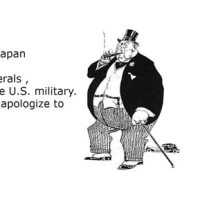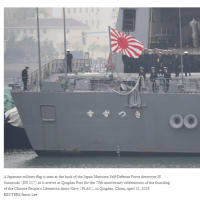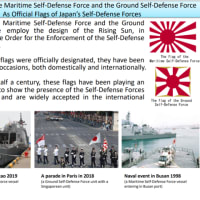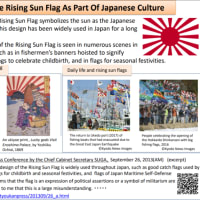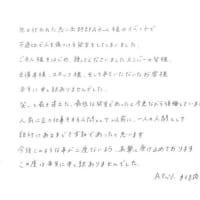http://www.debito.org/?p=9070#comment-253376
Level3 Says:
June 20th, 2011 at 11:38 pm
有道ブログで人種差別的瀬戸物販売店としていちゃもんをつけられた件について決着がついだようだ。
Apologies for the length of this. For those who just want the key part, skip to the photos and read points #1 and #4 under “facts”.
I went to Doguyasuji on Sunday to prove that the suspect shop will sell to non-Asians. There were 2 or 3 suspect cramped pottery/tableware shops I had in mind. I walked the length of Doguyasuji (about 170m, it’s not very big) to confirm there were no others. Only 2 had dishes on display stacked on the floor, making it scary to walk around in the aisles. 1 of those 2 had no English signs that I could find near the register or back of the shop. The last shop had 2 multi-lingual signs at the register, 1 exactly as Jessica described, about some items being out of stock and the last is only a sample and please be understanding. So, unless the description is wrong, it must have been the right shop. I snapped a photo with my keitai for reference. Adding to this there was a 40-ish female shop clerk who did not greet me or anyone really, plus maybe 5 or so male shop clerks. No huge “irasshaimase”, but the shop arcade was pretty busy with tourists it seemed, lots of people wandering zombie-like pre/post NGK show. I counted at least 6 Caucasian people as well in the short 10 minutes I was in the area.
So, on to the experiment. I located a cheap bowl. There were others of various patterns in the same size in the same stack. 350 yen. Took it and walked up to the register area. Waited my turn for a Japanese guy to buy something. I said nothing. Put the bowl on the counter. Clerk said “350円です”. I paid. He told me (in Japanese) I could wrap it myself at the table to the side (just as a large multilingual sign right next to the smaller sign about out of stock items indicated). I did, took a couple more photos on the way out, then went shopping in Minami… with a weighty, fragile ramen bowl in my bag. D’oh!
Photos at the link below:
http://www.flickr.com/photos/64229301@N03/sets/72157626870530597/
Facts and deductions:
1.I am white and I bought an item, just as I have many times over the years at this shop and others in Doguyasuji. This time I got a receipt and took a photo. I did not speak Japanese to the clerk beforehand. No blanket anti-foreigner policy. Photographic proof.
2.I think it’s very safe to assume this was the same shop Jessica reported on. There are no more than 10 dedicated pottery/tableware shops like this one along Doguyasuji. Only 2 are so crammed it’s hard to walk in the aisles as Jessica described. And only one of those had a sign about samples just like Jessica described. Unfortunately the auto focus on my fancy-schmancy keitai which I specifically bought for its 12Megapixel camera did not lock on well. But of course, I couldn’t tell this at the time on the 5cm screen. My ancient fixed-focus keitai would have been better! Lesson learned. You can still make out the word 「サンプル」”sample” and the ending 「..ません」”not____” so if you don’t trust me, make your own assumptions as to what a sign about “samples” and “not___” might be. But it basically said what Jessica reported, IIRC. And she could confirm if it was the basically the same size and layout as the sign she saw. Not photographic proof of the sign, but we all agree such a sign existed anyway! If I were dishonest and trying to discount that section of the story, I’d take a blurry photo on purpose and claim it WASN’T as Jessica described. Still, I wish it had come out well so we could parse the Japanese and English of the sign. Maybe another day. Moving on…
3.There was a 40-ish woman clerk. Maybe the clerk in question. Dyed reddish hair. All clerks wearing light green work jackets. If Jessica can confirm this, it would help.
4.There was also a sign at the register in Japanese, English, Korean and Chinese to please wrap your own purchases. This indicates that the shop intends to sell to English, Korean, and Chinese-speakers and foreigners in general, unless it is a cruel facade. The argument that the shop might only sell to Asians because they think the Asians are Japanese also falls flat. If so, why have Korean and Chinese signs about wrapping up your purchases? Photographic proof that the shop has a policy of foreign and Japanese customers wrapping their own purchases. Again, unless it is a cruel joke, this shows the shop allows foreigners to make purchases.
5.My cashier was not the woman, but she was right next to the cashier serving another customer’s request. I suppose it is possible that if she were on a solo racist crusade and there were no other clerks, she may have chosen not to sell to me.
6.While posting my photos I noticed an interesting thing. A poster for Peace Boat right under the register! A poster for an international cruise of multi-cultural understanding. (Debito was recruited by them as a speaker once, IIRC) Does this make sense if it’s a racist shop?
Theory
Most likely thing I can think of is the clerk was just busy with another issue, and is not as hyper polite as a clerk in Takashimaya, and didn’t/couldn’t spend time apologizing for being too busy to help her, thus Jessica felt ignored.
The closest I can come up with to a “racist” scenario is that the item was out of stock, or the item had been reserved or something (or the clerk mistakenly thought it so, it’s such a jumble in there I don’t know how they keep track). Jessica was a foreigner who admittedly couldn’t speak Japanese well, so the clerk assumed that Jessica did not have the ability to understand a full explanation of the situation in Japanese, assumed the non-Asian foreigner speaks English, and just pointed to the pre-made sign and went back to work.
Further, IF the shop was in the business of placing orders (they do have tons of catalogs lying around), the clerk knew she did not have the ability (or time, or willpower) to guide a non-Japanese speaker through the ordering process, nor the ability to explain that special ordering a single plate and shipping it is just impractical or under some minimum order limit for shipping. So, it just ends up being a case of bad communication. The only racism being the assumption Jessica can read the English sign because she’s not Asian.
Conclusions
I bought an item (and I have often done before) in the shop. Proving there is no blanket “no sales to non-Asians” policy. The female clerk on duty didn’t try to stop me. The shop has signs in English and other languages for customers to please wrap their purchases themselves, proving the shop caters to foreigners. Coincidentally, the shop has a Peace Boat poster in it right at the register, advertising a round-the-world cruise to meet people of different cultures.
All these facts stacked against Jessica’s assumption that what happened to her was racism. I submit that the facts establish it was most likely a case of bad communication rather than racism.
The only racism I could agree occurred was the clerk’s assumption that Jessica would be able to read the English sign because she was a non-Asian foreigner. On an exponential scale of 1 to 10 of racism, with 5 being banning races from shops, 8 being lynching and 10 being genocide (feel free to make up your own scale), I would put the assumption that a non-Asian foreigner in Japan can read English at a 0.5 – and the assumption that a Japanese person can’t sell you something is doing so because he/she is racist at about a 2.
Speculation
I would speculate that perhaps, having just seen a Debito presentation (I assume that’s the order of events here) on very real incidents of racism in Japan, Jessica’s racism awareness might have been a perked up, perhaps hyper alert, tending to seeing racism first and not seeing evidence to the contrary (such as the sign in English about wrapping your own purchases). Kind of like the rash of UFO reports after Close Encounters came out, or the smell of McDonald’s making me feel ill after seeing Supersize Me. A very human reaction.
Or, there is always a chance that the particular clerk was on a solo racist (or perhaps sexist?) crusade, but it sure sounds like a strange one. Not tailing a gaijin to make sure she isn’t shoplifting. Not preventing her from entering the store. Not trying to take advantage and shortchange her when purchasing or steer her to shoddy goods. Only revealing the “racism” when the potential customer wants to fork over some cash. Strange.
Her brief anecdote of the friend’s experience in the kimono shop reminds me of the similar issue with the barbershops that happened recently, which makes me think…
Discussion
That tricky issue of language, communication, and customer satisfaction. Are shops required to provide an explanation to all visitors in their native language as to why exactly their needs can’t be met? How much effort can be reasonably expected of shop clerks? Is a foreign customer responsible if their own lack of communication ability leads to a mistake (bad haircut, etc.) or is the shop liable? If we want to draw up such guidelines, would we want to apply them in our native countries as well? Do foreign customers have some responsibility to learn the language and accept communication breakdown as a lesson learned, study harder, hire a translator or recruit a friend to translate, or just move along to the next shop and hope things go better? Sounds like a good topic for a newspaper article.
What is the solution? Someday our keitais will provide instant translation, but until then, what are the rules? And how can we solve this issue if people jump to conclusions based on incomplete understanding?
A big step would be a better multilingual signs. Though it would be tricky, as many shops have particular needs. Of course, signs mean nothing if the customer chooses to believe the sign is a lie and the clerk is just a racist. On the other hand, such signs could be abused by clerks who put racism ahead of money, or are just feeling lazy.
More communication. Less jumping to conclusions. I think that’s a good rule in all areas of life, not just being a foreigner.
– An A-plus to you for investigation, documentation, and interpretation. Well done, and thank you very much for making the effort and investment. And I hope your purchase serves you well as a fine representation of this experience.
結果的にはもともとの報告者の事実誤認。
コミニケーションスキルを身につけましょう、と。
Level3氏による洞察も優れている。











